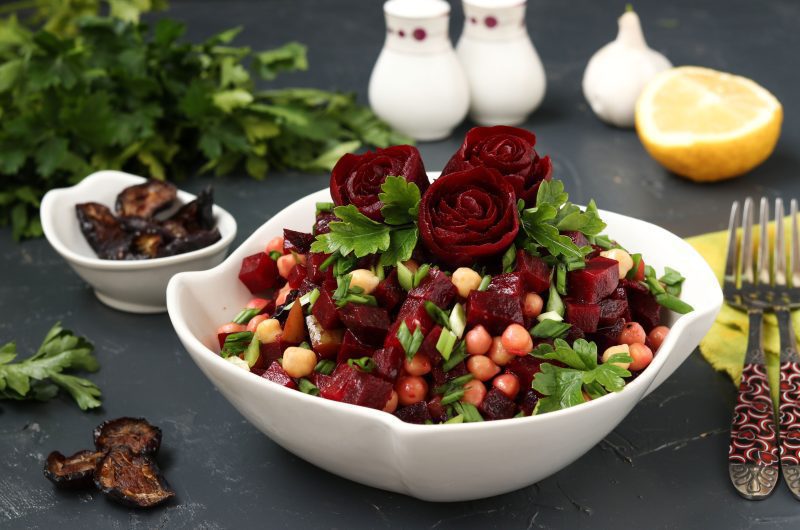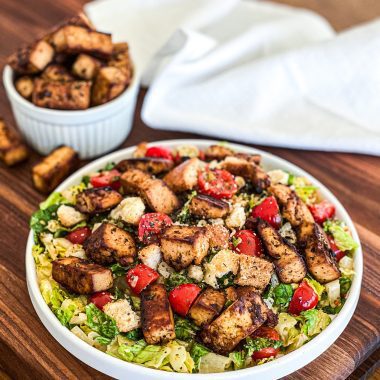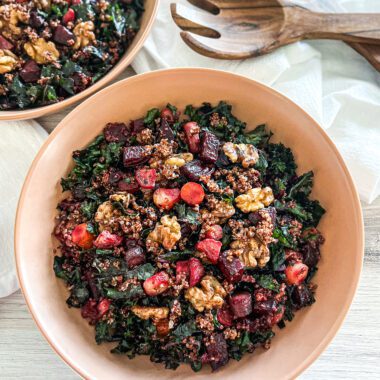When many people think of the color red, love, hearts, roses and other Valentine’s Day centric things, often come to mind. But red is so much more than Cupid’s color. It’s also the color of heart disease awareness. This topic is one that’s very close to my heart as my father died prematurely from a stroke and my mother currently lives with heart failure.
While many genetic and lifestyle factors contribute to the onset of heart disease, turns out, what you eat can significantly lower your overall risk. In fact, a lot of the whole food salad toppers we use at That Salad Lady are loaded with heart health-boosting antioxidants – and it just so happens that many boast beautiful red and reddish hues too.
Here, I’ll highlight some of these powerful red foods along with creative ways to include them in your salad making and everyday eating.
1. Beets
Among the most common root vegetables, beets are chock-full of nutrients, many that are difficult to get from other plant-based foods. Most notably, beets contain natural chemicals called nitrates that support blood pressure control and overall heart health. You can reap the full benefits of beets by eating them whole, or even drinking fresh beet juice. Try them in our “Roasted Beet Salad with Goat Cheese.” If you’re not a fan of beets, this recipe will convert you.
2. Tomato
Though commonly considered a vegetable, the tomato is actually a fruit, more specifically a berry. Whether cherry, grape, roma, beefsteak or vine, they’re all juicy, sweet and packed full of heart-healthy nutrients. Tomatoes are especially rich in antioxidants including vitamin C, vitamin E and lycopene, the phytonutrient that gives them their red color. They make a great choice for healthy snacking and many recipes like omelets, soups, stews and salads of course.
3. Sweet and Hot Red Peppers
Among the healthiest, tastiest salad ingredients, bell peppers are well-known for their superior nutrition profile. Of the many colors sold, red peppers are the brightest and best, as they’re the richest in phytonutrients. Hot red peppers come with the added health benefits of capsaicin. Capsaicin is the chemical compound that makes them hot and spicy, and it has powerful thermogenic effects that naturally help boost your body’s ability to burn fat.
4. Red Grapes
Unlike green grapes, the red ones contain an abundance of phytonutrients including anthocyanins, which produce deep red pigments. Anthocyanins naturally help lower blood pressure and may even improve blood cholesterol levels in ways that prevent the onset of heart disease. Red grapes also have a large presence of resveratrol, a phytonutrient known to protect against various cancers. Enjoy them with good protein in our “Rich and Creamy Chicken Salad.”
5. Red Kidney Beans
A flavorful, filling source of quality carbs, red kidney beans (or “red beans”) are rich in fiber, protein and a cocktail of health-promoting micronutrients. In addition to the anthocyanins they contain, red beans are particularly rich in slow-burning starch, which helps reduce blood sugar spikes. Due to the presence of this starch, regularly eating them can effectively lower LDL (“bad”) cholesterol. I make a killer Cajun-style red beans and rice dish that’s a must try.
6. Grapefruit
Like tomatoes, grapefruit is a great source of lycopene. It also contains large amounts of pectin, a type of fiber that promotes heart health by lowering LDL cholesterol. In addition, grapefruit is one of the best fruits for burning fat – so much so that there’s actually a grapefruit diet that promises rapid weight loss due to the fat-burning enzymes found in grapefruits. Now, I don’t recommend the diet, but I do recommend regularly enjoying grapefruit from time to time.
7. Red Berry Varieties
Whether strawberries, raspberries or even currants, all red berries house large amounts of vitamin C and those good old anthocyanins, which together help raise HDL (“good”) cholesterol in ways that protect against heart disease. The collection of nutrients in berries can also help fight cancer and ward off diabetes. Enjoy them as a quick and convenient snack, in smoothies or in our “Very Berrylicious Spinach Salad” and “Raspberry Walnut Vinaigrette Dressing.”
8. Red Quinoa
So, I simply couldn’t resist adding a grain to this list. Though quinoa comes in a variety of colors, due to its natural pigment, red quinoa contains the most phytonutrients. Quinoa is one of only a few plant-based foods that’s considered a complete protein, which means it contains all ‘essential’ amino acids. Red quinoa holds its texture slightly better than white quinoa so it’s a really good choice for salads.
And, there you have it: Eight red foods that promote a healthy heart. While eating these red foods doesn’t guarantee you won’t develop heart disease, doing so definitely stacks the odds in your favor. Heart disease itself is the leading cause of death worldwide. It kills roughly more people than cancer. In the United States alone, one person dies every 36 seconds from heart disease-related complications like heart attacks and strokes.
In the face of these stats, you gotta do what you gotta do in the lifestyle department. The beautiful thing is that you don’t have to eat all the foods on this list to reap heart health benefits. Combined with eating a rainbow of other whole foods, just one or two daily servings of these red foods, will get you well on your way to a healthier heart, and a healthier life.






